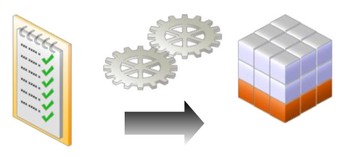About
Data Load Rules file is the second type of rules files which is involved in the data load process.
A data source for data load must contain :
- not only the values that you want to load
- but also identification of the location to which Essbase should load the values: a data address that includes one member from every standard dimension in your outline.
In addition to mapping metadata in data source to your dimension, rules files enable you to transform data upon loading in the following way :
- scale data
- change the sign of data
- Overwrite, add to, or subtract from existing data
Articles Related
Process for Creating Data Load Rules Files
To create a data load rules file:
- Determine whether to use the same rules file for data loads and dimension builds.
- Create a rules file.
- Set the file delimiters for the data source.
- Map each rules file field to the data source and define field properties.
- If necessary, set record, field, and data operations to change the data in the data source during loading.
- Validate and save the rules file.
Defining Data Load Field Properties
You must map each rules file field to the corresponding outline member, or as a data field or ignored field. Other field characteristics may also apply.
For duplicate member outlines, you must specify the method (level reference, generation reference, or parent-child reference) that Essbase uses to map the field.
- Level and generation references: The data source contains multiple fields within the duplicate member dimension to uniquely identify duplicate members.
- Use the level reference method when fields within a dimension are organized bottom-up in the data source.
- Use the generation reference method when fields within a dimension are organized top-down in the data source. For example:
gen2,Market, gen3,Market, Product, Year, Measures, Scenario, *data*
State,"New York","100-10",Jan,Sales,Actual,42
City,"New York","100-20",Jan,Sales Actual,82
State,Texas,"100-10",Jan,Sales,Actual,37
- Dimension reference: If an outline contains a duplicate member name in different dimensions—for example, a member name such as Other can be meaningful in different dimensions—you can use the dimension reference method. When you set a field to use the dimension reference method, you also identify the dimension to which members in that field belong. When the dimension reference method is specified for a field, Essbase checks to ensure that members in the field belong to the dimension specified for the field.
Requirements for Valid Data Load Rules Files
For a data load rules file to validate, all of the following questions must be answered “yes.”
- Is the rules file associated with the correct outline?
- Does each record in the data source contain only one member from each dimension?
- Are all member and dimension names spelled correctly?
- Are all members surrounded by quotation marks if they contain numbers or file delimiters?
- Are there no extra delimiters in the data source?
- Is the member that each data field maps to spelled correctly in the rules file?
- Are the file delimiters correctly placed?
- Is the member in the field name a valid member?
- Is the dimension name used in only one field (for example, not in a field name and the header)?
You can map a single data value to only one set of members.
- Is only one field defined as a data field?
- Is the Essbase - UDA used for sign flipping in the associated outline?

